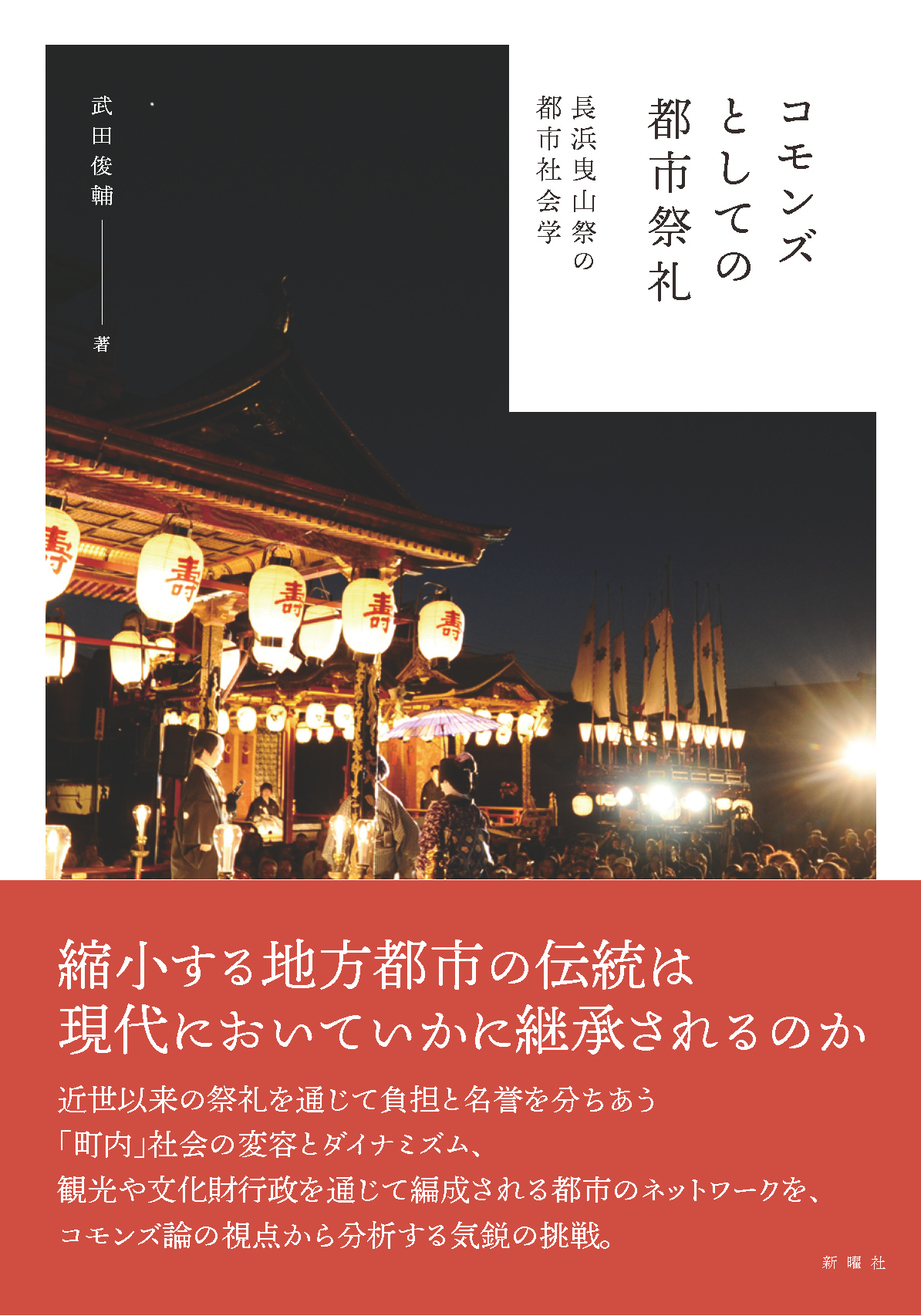
Title
Commons to shiteno Toshi-Sairei (Sociological Research of Local Festivals based on Commons Theory - The Case of Nagahama Hikiyama Festival in Japan)
Size
332 pages, A5 format
Language
Japanese
Released
April 08, 2019
ISBN
9784788516298
Published by
Shin-yō-sha
Book Info
See Book Availability at Library
Japanese Page
This book clarifies the social structures of Japanese cities with historical roots dating back to the medieval period. Many of these cities once thrived as castles or mercantile towns, and have inherited communities and cultures that find their roots in the Middle Ages. However, previous research on regional and urban sociology in Japan have not created an appropriate theoretical framework for analyzing their social structure, as most studies have regarded them as transforming and disappearing in the near future. Yet, traditional communities in such cities have endured while undergoing this change.
The author focuses on the theoretical potential of sociology of local community by Kizaemon Aruga and Takashi Nakano, which has been neglected by contemporary regional and urban sociology. Both of them investigated the social structure of communities in local cities by analyzing changes in the functions of mercantile ie (institutionalized households), and ie genealogical federations. In this book, the author renews their perspectives and develops a type of regional sociology that has not been discussed before by conducting research on the process of a local festival held by multiple chōnai (traditional communities consisting of ie federations) in Nagahama city, Shiga Prefecture.
The festival is here regarded as common property regime, in which each chōnai procures resources to generate and distribute scare benefits such as honor, and the residents share exciting experiences. All ie and chōnai compete for honor enthusiastically at the festival every year. While preparing for the festival, each chōnai procures resources such as labor, skills, money, and goods from each ie, the municipality, local economic organizations, and so on. These, on the one hand, distribute scare benefits as honorable gifts among ie and chōnai, and share the exciting experience of watching members of the chōnai battle for honor. On the other hand, the municipality and local economic organizations have the opportunity to utilize the festival as a tourist attraction and as an important cultural asset for the revitalization of local economy in exchange for resources. This book clarifies the social ties within local cities by analyzing the relationship between actors, created by the festival as common property regime.
Each ie tries to show prestige by gaining a higher status at the festival, and each chōnai shows its economic and cultural power by performing in the festival and competing with each another. In particular, ie that have lived in chōnai for generations and have invested resources in festivals are expected to gain a level of prestige matching their efforts. However, since only a few ie and chōnai can gain such prestige, conflicts often occur between them. Though such conflicts may seem to lead to the community’s collapse, people can actually become enthusiastic by watching and enjoy the festival. In addition, ie and chōnai that did not gain an honorable position expect to achieve it at future festivals. The reason that residents have inherited this festival for generations is to fulfill the expectation of being allocated prestigious positions, and to enjoy exciting experiences.
If the festival does not succeed, the residents’ expectations will not be fulfilled, and the reasons for inheriting the festival will be lost. After WW2, the festival tradition was found to be at risk many times because of a lack of resources, as local cities underwent social changes; consequentially, chōnai expanded their social networks to procure resources from new actors, such as the municipality, local economic organizations, schools, and the National Agency for Cultural Affairs, in return for opportunities to utilize the festival as local attraction.
This book clarifies social structure in the local city mediated by the festival, with the aim to analyze relationships and networks of ie and chōnai.
(Written by: TAKEDA Shunsuke / September 17, 2020)
Table of Contents
Chapter 1 The Purpose and Perspective of This Book
Chapter 2 Limitations and Potential of Theoretical Framework for Analyzing chōnai in Regional and Urban Sociology in Japan
Chapter 3 Research Angle: Sociological Research of Local Festivals based on Commons Theory
Part II Resources and Benefits of the Festival and its Dynamic Inheritance
Chapter 4 Ie and Generations in chōnai:Conflict on the Festival and its Dynamic Inheritance
Chapter 5 Control of Conflicts among Multiple chōnai and Sharing Enthusiastic Experiences: The Case of the “Praying Rally” (hadamakairi)
Chapter 6 Cooperation among Multiple chōnai and Reconstruction of chōnai after the 1960s
Chapter 7 Fundraising by Wakashu in chōnai and Utilization of Social Networking
Chapter 8 Community and Social Networking Mediated by Hikiyama Float: The Management System of Hikiyama as Common Resource
Part III Local Community and Social Networking in Cities Mediated by the Local Festival as Commons
Chapter 9 Tourist Attraction, Local Identity, Cultural Asset: Changing the Nominal Purpose of the Festival and Utilizing Social Networking in the City
Chapter 10 Conclusion
Related Info
The 46th (2020) Fujita Award (The Tokyo Institute for Municipal Research Oct, 2020)
https://www.timr.or.jp/research/fujita_award_41to50.html
The 13th Award of Japan Association of Regional and Community Studies (May 26, 2020)
http://jarcs.sakura.ne.jp/main/outline/main/2019_award_list.pdf
The 5th Award of Doctoral Dissertation by The Society of Lifeology (June 8th, 2019)
http://lifology.jp/overview/doctoral_thesis/



